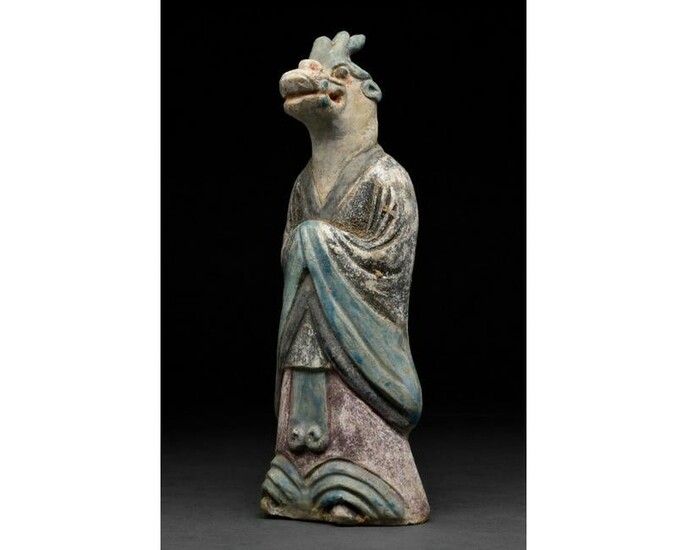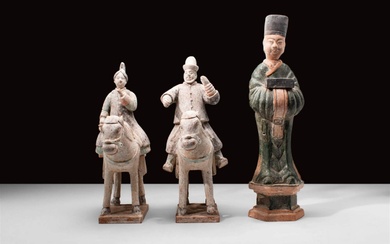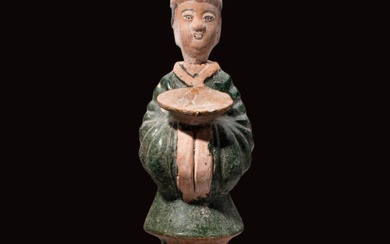CHINESE MING DYNASTY TERRACOTTA ZODIAC FIGURE
Ca. 1368-1644 AD. Ming Dynasty. An elaborate terracotta zodiac figure in a court dress or shenyi consisting of a long waistcoat tied at the waist over a purple dress with long flaring sleeves. The robe is dark blue with light blue accents on the sleeves. The hands are folded in front of the chest. The figure is extremely detailed and beautifully glazed in turquoise and cobalt blue colours. The cloaked human body is standing frontal with the head of an animal from the Chinese zodiac – in this case, the snake. The Chinese zodiac is a method of counting years based on the Chinese lunar calendar which assigns every year with a representative animal in a repeating 12-year cycle. Each animal is also associated with a natural element in the Earthly Branch. The twelve Zodiacs are the rat, ox, tiger, rabbit, dragon, snake, horse, sheep, monkey, rooster, dog, and pig or boar. These correspond to the twelve Earthly Branches and are infrequently found in wealthy tombs of the elite and wealthy ancient Ming Chinese. The tradition of sculpting terracotta figurines into zodiac representations might have originated during the Han Dynasty. Normally zodiac figures from the Ming dynasty have human heads and they hold the zodiac emblem animal in their hands. The zodiac figures were often placed in a north-south direction in coffin chambers to represent the progress of time. People hoped that such an arrangement would encourage the god to time to guard the tomb. For a general overview of the art of the Ming Dynasty, see Department of Asian Art. (2000). "Ming Dynasty (1368-1644)"; In Heilbrunn Timeline of Art History. New York: The Metropolitan Museum of Art (http://www.metmuseum.org/toah/hd/ming/hd_ming.htm) Size: L:223mm / W:85mm ; 445g. Provenance: UK private collection of Asian Art; formerly acquired in the early 1990s in Hong Kong.
[ translate ]View it on
Sale price
Estimate
Time, Location
Auction House
Ca. 1368-1644 AD. Ming Dynasty. An elaborate terracotta zodiac figure in a court dress or shenyi consisting of a long waistcoat tied at the waist over a purple dress with long flaring sleeves. The robe is dark blue with light blue accents on the sleeves. The hands are folded in front of the chest. The figure is extremely detailed and beautifully glazed in turquoise and cobalt blue colours. The cloaked human body is standing frontal with the head of an animal from the Chinese zodiac – in this case, the snake. The Chinese zodiac is a method of counting years based on the Chinese lunar calendar which assigns every year with a representative animal in a repeating 12-year cycle. Each animal is also associated with a natural element in the Earthly Branch. The twelve Zodiacs are the rat, ox, tiger, rabbit, dragon, snake, horse, sheep, monkey, rooster, dog, and pig or boar. These correspond to the twelve Earthly Branches and are infrequently found in wealthy tombs of the elite and wealthy ancient Ming Chinese. The tradition of sculpting terracotta figurines into zodiac representations might have originated during the Han Dynasty. Normally zodiac figures from the Ming dynasty have human heads and they hold the zodiac emblem animal in their hands. The zodiac figures were often placed in a north-south direction in coffin chambers to represent the progress of time. People hoped that such an arrangement would encourage the god to time to guard the tomb. For a general overview of the art of the Ming Dynasty, see Department of Asian Art. (2000). "Ming Dynasty (1368-1644)"; In Heilbrunn Timeline of Art History. New York: The Metropolitan Museum of Art (http://www.metmuseum.org/toah/hd/ming/hd_ming.htm) Size: L:223mm / W:85mm ; 445g. Provenance: UK private collection of Asian Art; formerly acquired in the early 1990s in Hong Kong.
[ translate ]




